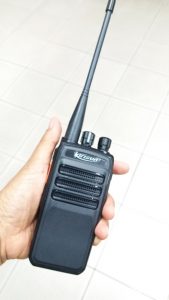Introduction:
When it comes to two-way radios, the choice between VHF vs UHF is a pivotal decision that significantly influences the effectiveness of communication. Both frequency bands come with their unique advantages and considerations, making the determination of the best radio frequency contingent upon specific use cases. In this article, we’ll explore the characteristics of VHF and UHF, helping you navigate the intricacies to make an informed decision tailored to your communication needs.

Understanding VHF vs UHF:
1. VHF (Very High Frequency):
– Frequency Range: 30 MHz to 300 MHz
– Wavelengths: Longer wavelengths
– Characteristics: VHF signals travel in longer waves, making them proficient in long-range communication in open areas. However, they face challenges penetrating obstacles like buildings.
2. UHF (Ultra High Frequency):
– Frequency Range: 300 MHz to 3 GHz
– Wavelengths: Shorter wavelengths
– Characteristics: UHF signals, with shorter wavelengths, excel at penetrating obstacles like buildings and forests. They are ideal for urban environments with numerous obstructions.
VHF vs UHF
Advantages of VHF:
1. VHF vs UHF: Longer Range in Open Areas
VHF signals, due to their longer wavelengths, can cover longer distances in open spaces. This makes them optimal for outdoor activities such as hiking, camping, and open-field communication.
2. Less Susceptible to Signal Absorption by Water:
VHF signals exhibit lower susceptibility to absorption by water, making them suitable for maritime communication where water obstacles are prevalent.
3. Suitable for Long-Distance Communication:
VHF frequencies are well-suited for applications that demand long-distance communication, such as aviation where air traffic control and aircraft-to-aircraft communication rely on VHF.
Considerations for VHF:
1. Limited Penetration Through Obstacles:
VHF signals struggle to penetrate obstacles like buildings and dense vegetation. In urban environments or areas with numerous obstacles, the range and effectiveness of VHF may be compromised.
2. Larger Antennas May Be Required:
Due to their longer wavelengths, VHF signals may necessitate larger antennas for optimal performance. This could impact the portability of devices operating on VHF frequencies.
Advantages of UHF:
1. Better Penetration Through Obstacles:
UHF signals, with their shorter wavelengths, excel at penetrating obstacles like buildings and forests. This makes them ideal for communication in urban environments or areas with dense vegetation.
2. VHF vs UHF: Effective in Urban Environments
UHF frequencies are well-suited for urban communication where buildings and structures can obstruct signals. They provide reliable communication within buildings and across short to medium distances.
3. Smaller Antennas Enhance Portability:
The shorter wavelengths of UHF signals allow for the use of smaller antennas, enhancing the portability of devices operating on UHF frequencies.
Considerations for UHF:
1. Shorter Effective Range in Open Areas:
While UHF is effective in penetrating obstacles, its effective range in open areas may be shorter compared to VHF. This makes it essential to consider the specific communication needs of the environment.
2. Increased Susceptibility to Signal Absorption by Water:
UHF signals are more susceptible to absorption by water. In scenarios where water obstacles are prevalent, such as maritime communication, this characteristic should be taken into account.
Conclusion:
The determination of whether VHF or UHF is the “best” radio frequency hinges on the specific requirements of your communication scenario. In open spaces with a need for long-range communication, VHF might be the preferred choice. Conversely, in urban environments with obstacles demanding superior signal penetration, UHF emerges as the optimal solution. Whether you’re embarking on outdoor adventures, managing business operations, or responding to emergencies, a nuanced understanding of the characteristics and considerations of VHF and UHF frequencies empowers you to make an informed decision. The best frequency is the one that aligns seamlessly with the unique demands of your communication environment, ensuring that your two-way radios perform optimally in any setting.







